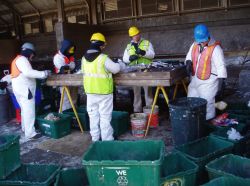State-wide Solid Waste
Composition and Characterization Studies
 Besides being compelled by the State's Solid Waste Management Plan, now referred to as the Comprehensive Materials Management Strategy (CMMS) to complete such a study, it makes good planning sense to know what is present in our waste stream. Having accurate data on the type of materials we are throwing away and in what quantity will help guide our implementation of waste reduction, reuse and recycling efforts state-wide.
The results of the first state-wide municipal solid waste (MSW) composition and characterization study were released in 2010 and the Department will continue to periodically conduct new and replicate studies as recycling markets, waste collection methods, packaging products, etc. evolve. This webpage provides links to current and proposed comprehensive waste characterization studies which reflect Connecticut's disposal and diversion rates and how the composition of our waste stream is effected by our materials management efforts over time.
Besides being compelled by the State's Solid Waste Management Plan, now referred to as the Comprehensive Materials Management Strategy (CMMS) to complete such a study, it makes good planning sense to know what is present in our waste stream. Having accurate data on the type of materials we are throwing away and in what quantity will help guide our implementation of waste reduction, reuse and recycling efforts state-wide.
The results of the first state-wide municipal solid waste (MSW) composition and characterization study were released in 2010 and the Department will continue to periodically conduct new and replicate studies as recycling markets, waste collection methods, packaging products, etc. evolve. This webpage provides links to current and proposed comprehensive waste characterization studies which reflect Connecticut's disposal and diversion rates and how the composition of our waste stream is effected by our materials management efforts over time.
| State-wide Solid Waste Composition and Characterization Studies | |
|
2015
|
|
| Background/Summary | The 2015 studies analyzed both Municipal Solid Waste (MSW) produced by residential and commercials generators, and Construction and Demolition (C&D) wastes generated in the state. The MSW study will provide reliable estimates of the composition of MSW statewide, the presence of redeemable bottle-bill materials in the waste and curbside recycling streams, potential contamination of the curbside recycling stream, and the composition of waste disposed by large commercial generators. The C&D study will be the first of its kind for the state, and will shed light on the complex market dynamics and flow of materials through in-state and out-of-state processing facilities, as well as identifying strategies to increase the recycling of materials recovered from C&D waste. |
| Final Report (MSW) | 2015 State-wide Municipal Solid Waste Composition and Characterization Study |
| Final Report (C&D) | 2016 State-wide Construction and Demolition Waste Composition and Market Analysis |
|
#DEEP-MMCA-0112015
|
The Connecticut Department of Energy and Environmental Protection sought proposals for (1) a State-Wide Municipal Solid Waste (MSW) Composition and Characterization Study, and (2) a Construction and Demolition Waste Characterization and Market Analysis. Contractors had the opportunity to bid on one or both.
|
|
2008
|
|
|
Background/Summary
|
In the 2006 State-wide Solid Waste Management Plan, Strategy 6-7 required that the Department conduct a solid waste characterization study for the purpose of better targeting waste disposal diversion efforts and estimating associated costs for managing the waste stream. In addition, in the Department’s Hearing Officer’s Report (dated November 2006) leading up to the Plan’s adoption, indicated that the Department would continue to monitor the State’s disposal diversion rates and conduct a comprehensive analysis of the disposal diversion rate by 2016. In the fall of 2008, the Department retained the services of DSM Environmental Services, Inc. (DSM) to conduct a project entitled: State-wide Solid Waste Composition and Characterization Study. This was the Department’s first such study and one of the very few that had been conducted in the northeast region. In May 2010, the final report was completed and a presentation was given to the Solid Waste Advisory Committee at the May meeting. The State-wide Solid Waste Composition and Characterization Study (the Study) consists of: two seasonal sampling and sorting of material events (Spring/Fall 2009) at five permitted solid waste facilities (four RRF; one transfer station); an interim report based on the first sorting event; and a final report. |
|
May 26, 2010
|
Connecticut State-wide Solid Waste Composition and Characterization Study
|
|
July 9, 2009
|
Results of First Round of Sampling. Describes the results of sampling done at five CT facilities.
|
|
February 2009
|
Final study design outlines: roles and responsibilities; site coordination and communication; training and supervision; sampling plan; acquisition of samples; characterization of samples; data QA/QC procedure; and appendices – waste categories; field forms; and health and safety plan. A memo from DSM to DEP dated Feb. 27, 2009 outlines readjustment to the Study Design.
|
|
The purpose of the RFP was to provide information for proposals for a state-wide MSW composition and characterization study. This study focuses on the disposed waste stream and not on materials that have been diverted through recycling, composting, or source reduction.
|
|

